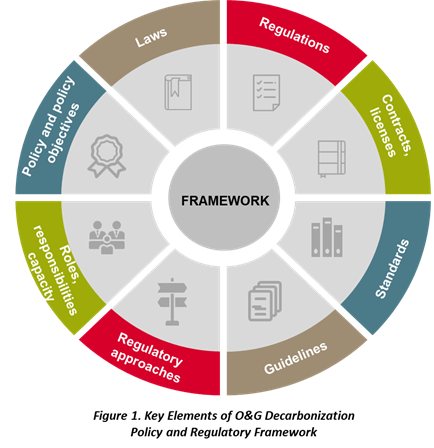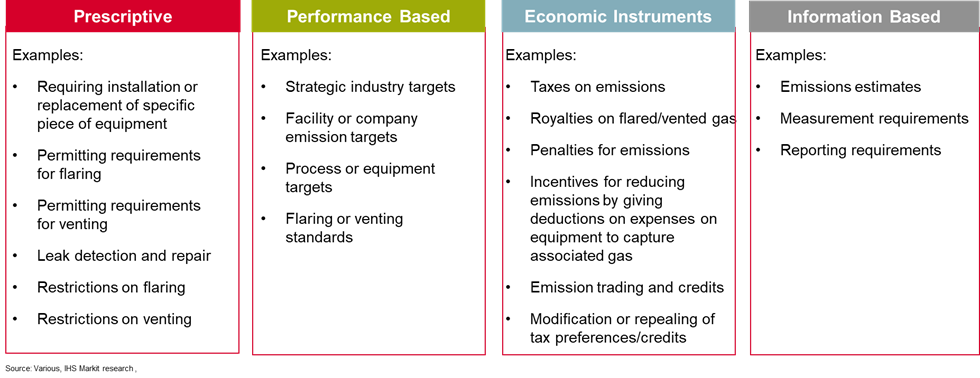Customer Logins
Obtain the data you need to make the most informed decisions by accessing our extensive portfolio of information, analytics, and expertise. Sign in to the product or service center of your choice.
Customer Logins
BLOG
May 02, 2023
Considerations in developing O&G decarbonization regulatory framework
Well-thought-out governmental policies and an effective supporting regulatory framework are critical factors in reduction of greenhouse gas (GHG) emissions derived from oil and gas (O&G) operations. Globally, the regulatory framework for O&G decarbonization is evolving rapidly as countries seek to either meet national- or industry-specific climate targets deriving from international and national commitments. As both oil and natural gas will continue to play significant roles in the energy mix for years, if not decades, to come, developing robust policies, laws and regulations supporting decarbonization of the O&G industry is of paramount importance.
Key elements of the O&G decarbonization regulatory framework
While the regulatory framework for O&G decarbonization varies by country and region, some common global themes, approaches, and measures have been developed. A well-structured O&G decarbonization policy and regulatory framework typically comprises of several essential components as illustrated in Figure 1, all of which must be sufficiently developed.

Key elements of the framework may include among others the
following components:
- Clearly defined O&G decarbonization policy objectives and measures
- Defined roles and responsibilities of state bodies and stakeholders and their having the capacities and capabilities to execute such responsibilities
- Suitable selected regulatory approach(-es)
- New or revised laws and supporting regulations defining decarbonization requirements
- Decarbonization provisions to be included into relevant (model) petroleum contracts and licenses (as and where applicable)
- Decarbonization provisions to be included into relevant standards and guidelines (where applicable)
Country's readiness to adopt O&G decarbonization regulatory requirements
In setting and prioritizing policies and requirements for a national O&G decarbonization regulatory framework, it is critical to assess the country's commercial and institutional readiness to implement any policy and regulatory measures. This assessment shall consider as a minimum several factor such as:
- Physical volume and types of GHG emissions
- The capacity/capability of regulators to implement policy initiatives and enforce compliance with proposed decarbonization regulatory requirements
- The overall impact of proposed measures on the overall profitability of O&G projects
These factors will help to prioritise measures that shall be implement first to achieve defined goals.
Regulatory approaches for setting O&G decarbonization regulatory framework
Depending on a country's circumstances and the maturity of decarbonization policies, O&G decarbonization regulatory approaches and measures can broadly be categorized under four categories: 1) prescriptive, 2) performance-based, 3) economic instruments; and 4) information-based, and 4)
Under the prescriptive approach, companies are directed to undertake specific actions or procedures. To this end, prescriptive requirements may set procedural, equipment or technological requirements. Key advantages of this approach include potential for reduction of overall GHG emissions without establishing an emissions' baseline or a continuous monitoring program. However, measures implemented under this approach may not be the most cost-effective, as companies may not be incentivized to seek out more efficient strategies to decarbonize.
Under the performance-based approach, performance standards for O&G companies are established, but they do not dictate how the target must be achieved. With this approach companies can seek the most cost-effective compliance solution and encourage technological developments. However, for this approach to be successful, both parties must have accurate baseline data and reliable mechanisms to track progress, which may require significant monitoring efforts and emissions estimation.
Under the economic instruments approach regulations provide industry with a choice of reducing GHG emissions or paying for GHG released, effectively changing the abatement cost curve. With this approach companies are free to seek the most cost-effective methods of GHG emission reduction, thereby encouraging innovation. It can also mobilize other stakeholders in research and development. However, it requires a structured information base and a robust monitoring, reporting and verification system.
The information-based approach aims to bridge information gaps and equip regulators, industry and the public with better information about key problem sources and opportunities. This approach has relatively low implementation costs but may have only a relatively low impact on GHG emission reduction since it doesn't require direct action to this effect.
O&G regulatory decarbonization measures that can be adopted under the suite of petroleum, natural gas, environmental, climate, tax and other relevant legislation, petroleum contracts and licensees, and supporting standards and guidelines, typically include:
- Setting targets
- Permitting/approvals
- Requirements for adoption of specific measures, processes, procedures
- R&D and project funding
- Performance based requirements
- Economic incentives and regulatory penalties
- Carbon pricing
These measures, classified under different approaches, are illustrated in Figure 2. Regulators typically use a mix of different approaches or can move from one to another to once the regulatory framework matures or better data and monitoring capabilities are developed by regulators.

Figure 2. Classification of O&G decarbonization measures under different regulatory approaches
Marginal abatement cost curve - a tool to inform priority for implementing O&G decarbonization regulatory requirements
One of the useful tools in assessing appropriateness of proposed regulatory measures in developing an O&G decarbonization regulatory framework is a marginal abatement cost curve (MACC). MACC is an industry tool that helps users to visualise the implementation priority of different abatement measures and as such, may support national policy and regulatory developments. As illustrated in Figure 3, the costs and implementation challenges of different MACC abatement options can be ranked with due consideration of their relative effectiveness.
 Figure 3. Example of prioritization of
policy measures based on MAAC abatement
options
Figure 3. Example of prioritization of
policy measures based on MAAC abatement
options
Typically, abatement measure implementation strategies are developed with due consideration of cost parameters, with low-cost measures usually addressed first. As such, MACC can be a highly effective guide in proposing and developing O&G regulatory measures that support country-specific decarbonization plans.
For more information contact Yelena Shliomenzon and Jim Thomas.
This article was published by S&P Global Commodity Insights and not by S&P Global Ratings, which is a separately managed division of S&P Global.
{"items" : [
{"name":"share","enabled":true,"desc":"<strong>Share</strong>","mobdesc":"Share","options":[ {"name":"facebook","url":"https://www.facebook.com/sharer.php?u=http%3a%2f%2fssl.ihsmarkit.com%2fcommodityinsights%2fen%2fci%2fresearch-analysis%2fconsiderations-in-developing-og-decarbonization-regulatory-fra.html","enabled":true},{"name":"twitter","url":"https://twitter.com/intent/tweet?url=http%3a%2f%2fssl.ihsmarkit.com%2fcommodityinsights%2fen%2fci%2fresearch-analysis%2fconsiderations-in-developing-og-decarbonization-regulatory-fra.html&text=Considerations+in+developing+O%26G+decarbonization+regulatory+framework++%7c+S%26P+Global+","enabled":true},{"name":"linkedin","url":"https://www.linkedin.com/sharing/share-offsite/?url=http%3a%2f%2fssl.ihsmarkit.com%2fcommodityinsights%2fen%2fci%2fresearch-analysis%2fconsiderations-in-developing-og-decarbonization-regulatory-fra.html","enabled":true},{"name":"email","url":"?subject=Considerations in developing O&G decarbonization regulatory framework | S&P Global &body=http%3a%2f%2fssl.ihsmarkit.com%2fcommodityinsights%2fen%2fci%2fresearch-analysis%2fconsiderations-in-developing-og-decarbonization-regulatory-fra.html","enabled":true},{"name":"whatsapp","url":"https://api.whatsapp.com/send?text=Considerations+in+developing+O%26G+decarbonization+regulatory+framework++%7c+S%26P+Global+ http%3a%2f%2fssl.ihsmarkit.com%2fcommodityinsights%2fen%2fci%2fresearch-analysis%2fconsiderations-in-developing-og-decarbonization-regulatory-fra.html","enabled":true}]}, {"name":"rtt","enabled":true,"mobdesc":"Top"}
]}

